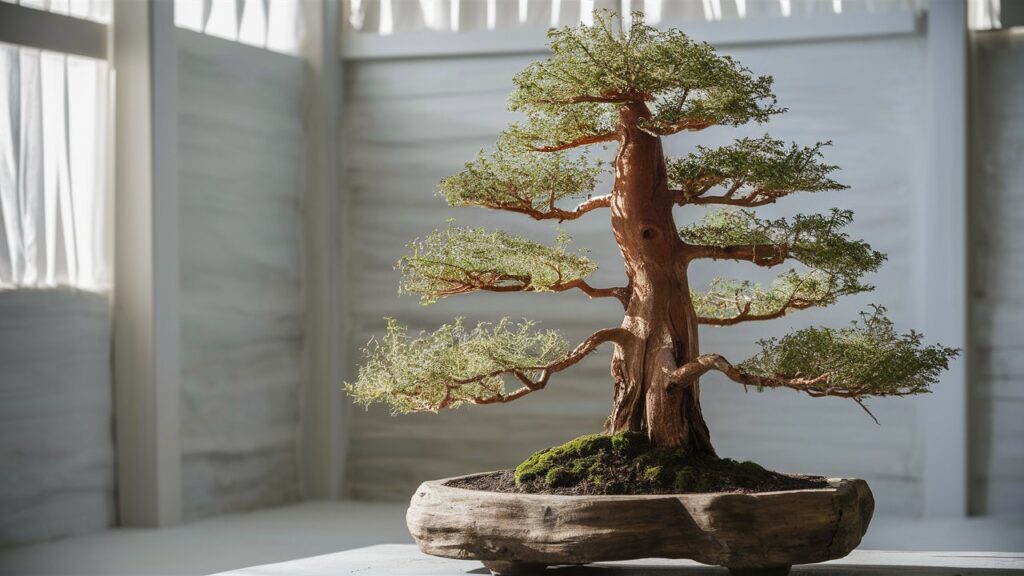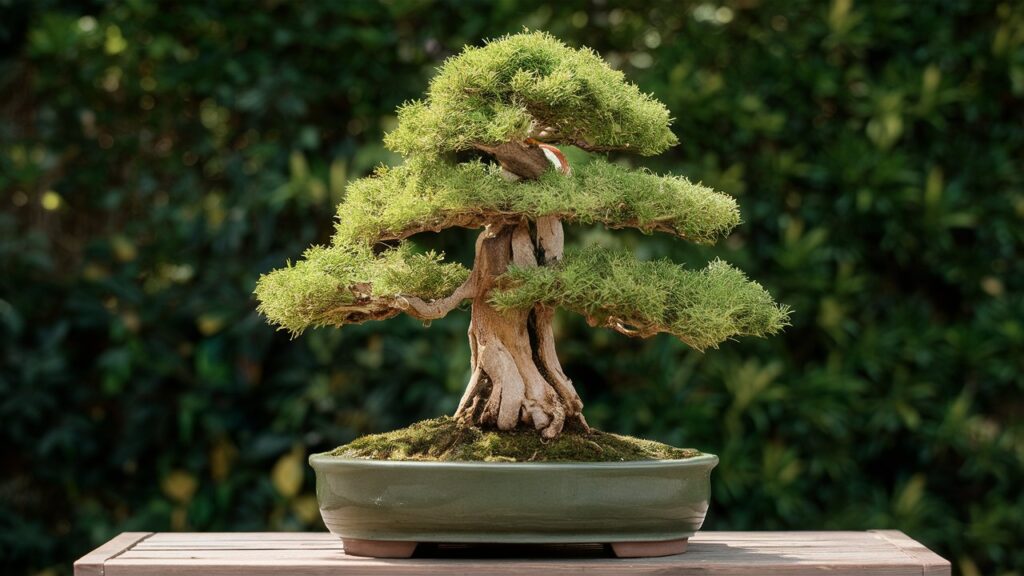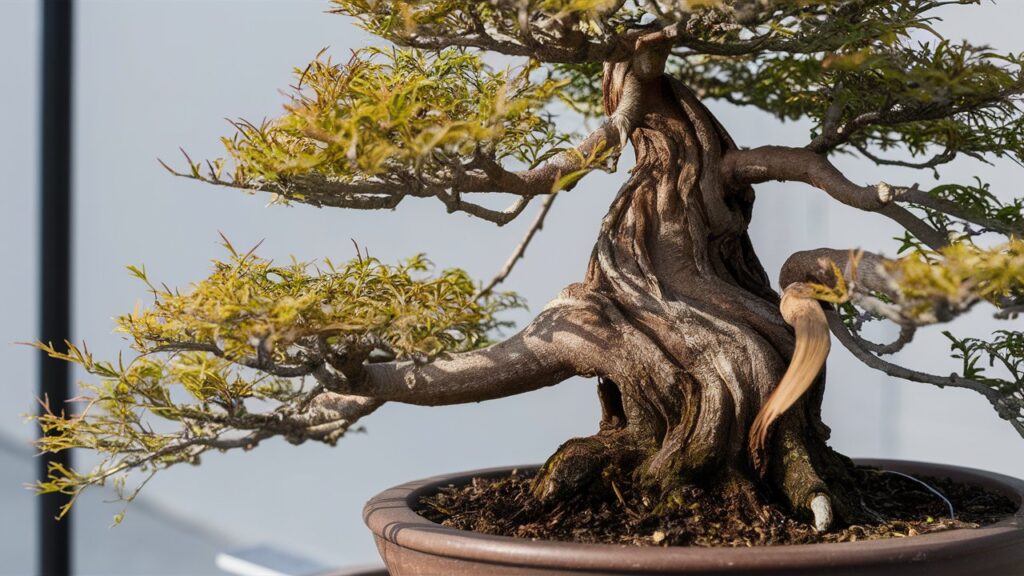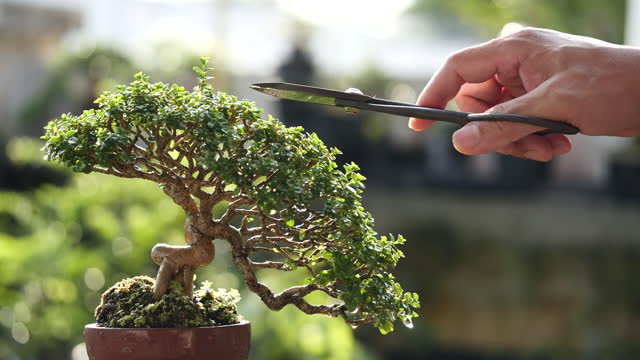Redwood bonsai trees have unique qualities that make them stand out in any collection. Their tall trunks, distinct foliage, and enchanting appeal contribute to their beauty as stunning tree art. We will explore these characteristics and their impact on bonsai aesthetics.
There are two main species of redwood trees used for bonsai: coast redwoods and dawn redwoods. Each species has unique growth habits and charm, which we will discuss to help you make informed choices for your redwood bonsai tree.
Understanding the Unique Qualities of the Redwood Bonsai Tree
Redwood bonsai trees are unlike any other bonsai tree species. They possess distinct characteristics that make them truly captivating and ideal for bonsai gardening and tree art. Let’s explore the unique qualities that set redwood bonsai trees apart.
“Redwood bonsai trees stand tall and majestic, showcasing their grandeur in miniature form.”
One of their most striking features is their tall upright trunks. Redwood bonsai trees emulate the towering height of their full-sized counterparts, creating a sense of awe and admiration. The miniature redwood recreates the majesty of the full-sized tree, allowing enthusiasts to appreciate their beauty in a compact and manageable form.
“The distinct foliage of redwood bonsai trees adds an artistic touch to their overall appeal.”
The foliage of redwood bonsai trees is highly unique. With flattened sprays of vibrant green leaves, they add texture and depth to the bonsai composition. The delicate yet resilient foliage enhances the artistic potential of the redwood bonsai, offering endless possibilities for shaping and styling.
Redwood bonsai trees serve as a testament to the creativity and skill of bonsai artists. Their unique qualities make them an excellent choice for anyone looking to cultivate a bonsai collection that truly stands out. So, let your imagination soar as you explore the artistic potential of the redwood bonsai tree.
Redwood Bonsai Tree Species
The Majestic Coast Redwoods

The coast redwood (Sequoia sempervirens) is one of the most iconic species used for redwood bonsai trees. Known for its incredible height and strong growth, the coast redwood is a majestic and impressive tree. In the wild, these trees can reach heights of over 300 feet, making them the tallest trees on Earth.
Coast redwoods have thick, reddish-brown bark that becomes fibrous with age, adding to their unique aesthetic appeal. Their foliage consists of feathery needles that are green on top and bluish-green beneath, creating a stunning contrast.
When cultivated as bonsai, coast redwoods can exhibit the same awe-inspiring beauty and grandeur as their full-sized counterparts. With proper care and attention, these miniature versions of the coast redwood can thrive and become captivating pieces of tree art.
The Historical Dawn Redwoods

The dawn redwood (Metasequoia glyptostroboides) is an intriguing species that is often referred to as a “living fossil.” This ancient tree species was thought to be extinct until it was discovered based on fossil evidence in the 1940s. Since then, dawn redwoods have become popular choices for bonsai gardening.
Dawn redwoods have a unique growth pattern, with a slender trunk and delicate branches that create a graceful appearance. Their foliage consists of soft, fern-like leaves that turn a beautiful golden-orange color in the fall, adding to their appeal as bonsai trees.
Cultivating dawn redwood bonsai trees allows bonsai enthusiasts to connect with the history and evolution of trees. These living fossils provide a captivating glimpse into the past while offering endless possibilities for artistic expression in the present.
The Essential Environmental Conditions for Your Redwood Bonsai Tree
Optimal Placement and Sunlight Needs
Proper placement is crucial for the health and growth of your redwood bonsai tree. These trees require a location that provides them with the right amount of sunlight and protection from extreme temperatures. Here are some important considerations for optimal placement:
- Sunlight: Redwood bonsai trees thrive in bright, indirect sunlight. Place your tree in an area where it can receive at least 4-6 hours of sunlight each day. However, be cautious of excessive direct sunlight, especially during the hot summer months, as it can lead to sunburn and leaf damage.
- Indoor vs. Outdoor: Redwood bonsai trees can be grown both indoors and outdoors. If you choose to keep your tree indoors, place it near a south-facing window where it can receive ample sunlight. Outdoor placement should be in a location with partial shade, especially during the hottest parts of the day.
- Shelter: Protect your redwood bonsai tree from strong winds and heavy rain. Placing it near a wall or under the cover of a taller plant can help provide the necessary protection.
Protecting Your Redwood Bonsai from Extreme Temperatures
Redwood bonsai trees are sensitive to extreme temperature fluctuations. Here are some tips to safeguard your tree from temperature-related stress:
- Cold weather: Redwood bonsai trees can tolerate cooler temperatures down to around 20°F (-6°C). However, it’s essential to protect them from freezing temperatures by bringing them indoors or placing them in a sheltered location during winter.
- Hot weather: Redwood bonsai trees prefer mild to moderately warm temperatures. If you live in an area with scorching summers, consider shading your tree during the hottest part of the day or relocating it to a cooler spot. Adequate airflow and regular misting can also help prevent heat stress.
By understanding and providing the essential environmental conditions for your redwood bonsai tree, you can ensure its optimal growth and well-being. Remember to find the right balance of sunlight, protection, and temperature control to create a thriving environment for your redwood bonsai.
Mastering Watering Techniques for a Healthy Redwood Bonsai

Proper watering is crucial for the health and vitality of redwood bonsai trees. These unique trees have specific watering requirements that must be met to ensure their well-being. In this section, we will explore different watering techniques and strategies to help you master the art of watering your redwood bonsai.
1. Understanding the Watering Needs
Redwood bonsai trees prefer consistently moist soil, but it is essential to avoid overwatering, as it can lead to root rot and other issues. Before watering, always check the moisture levels of the soil to determine if watering is necessary. A good technique is to insert a wooden skewer into the soil; if it comes out slightly damp, your bonsai has sufficient moisture.
2. Watering Frequency and Amount
Redwood bonsai trees typically require more frequent watering compared to other bonsai species. As a general rule, water your redwood bonsai when the soil starts to feel slightly dry to the touch. However, avoid frequent shallow watering as it can lead to poor root development. Instead, water deeply, allowing the water to penetrate the entire root system.
3. Watering Techniques
There are several effective watering techniques that can help ensure your redwood bonsai receives the right amount of moisture:
- Submerging: Place your redwood bonsai pot in a basin of water and allow it to soak until the soil is thoroughly and evenly moistened.
- Top Watering: Gently pour water onto the soil surface, ensuring the water reaches all areas of the pot. Take care not to disturb the soil or foliage.
- Misting: Mist the leaves of your redwood bonsai tree regularly to increase humidity and prevent dehydration.
4. Avoiding Common Watering Mistakes
To ensure the health of your redwood bonsai, be mindful of these common watering mistakes:
- Overwatering: Avoid the temptation to water your redwood bonsai excessively, as it can lead to root rot and other problems.
- Underwatering: Redwood bonsai trees need consistent moisture, so do not let the soil dry out completely between waterings.
- Watering on a Schedule: Instead of watering on a rigid schedule, observe your redwood bonsai’s specific needs and adjust accordingly.
5. Maintaining Proper Soil Moisture
Consistently monitoring and maintaining the proper soil moisture is essential for the health of your redwood bonsai tree. Some tips to help you achieve this:
- Well-Draining Soil: Ensure that your redwood bonsai is planted in a well-draining soil mix that retains moisture without becoming waterlogged.
- Use a Humidity Tray: Placing your redwood bonsai pot on a humidity tray filled with water can help increase humidity levels around the tree, preventing the soil from drying out too quickly.
- Protect from Direct Sunlight: Redwood bonsai trees can be sensitive to intense sunlight, which can quickly dry out the soil. Shield your bonsai from direct sunlight during the hottest parts of the day.
By mastering watering techniques and understanding the unique watering needs of redwood bonsai trees, you can ensure the health and vitality of your miniature masterpiece. Proper watering contributes to the overall beauty and longevity of your redwood bonsai, allowing you to enjoy its captivating presence for years to come.
Fertilizing Your Redwood Bonsai: Timing and Nutrient Requirements
Fertilization is essential for the growth and development of your redwood bonsai tree. Proper timing and nutrient requirements play a crucial role in ensuring its health and vitality. In this section, we will explore the best practices for fertilizing your redwood bonsai and provide guidance on choosing the right fertilizer to meet its specific needs.
Choosing the Right Fertilizer
When it comes to fertilizing your redwood bonsai, selecting the appropriate fertilizer is paramount. Consider the following factors to make an informed decision:
- Nutrient Content: Opt for a well-balanced fertilizer with a higher nitrogen (N) content to promote healthy foliage growth and overall vigor.
- Slow-Release or Liquid: Choose between slow-release pellets or liquid fertilizers, depending on your preference and the specific needs of your redwood bonsai.
- Organic or Synthetic: Both organic and synthetic fertilizers can be effective. Organic options provide slow and steady nutrient release, while synthetic fertilizers offer a more immediate boost.
By considering these factors, you can select a fertilizer that meets the nutrient requirements of your redwood bonsai tree and promotes its overall well-being.
Preventing Overgrowth Through Controlled Fertilization
While fertilization is crucial for the health of your redwood bonsai, it’s essential to prevent overgrowth by implementing controlled fertilization practices. Here are some tips to ensure optimal growth without causing excessive and unruly foliage:
- Timing: Fertilize your redwood bonsai during the growing season, typically from early spring to early autumn. This helps maintain a balance between growth and controlled development.
- Dilution: Dilute the fertilizer to half or quarter strength to avoid overwhelming your bonsai with excessive nutrients.
- Frequency: Apply fertilizer sparingly and consistently at regular intervals, rather than in large quantities all at once.
- Monitoring: Regularly observe the growth patterns of your redwood bonsai and adjust the fertilization regimen accordingly to prevent excessive growth and maintain its desired form.
By implementing these controlled fertilization techniques, you can prevent overgrowth and maintain the aesthetic appeal of your redwood bonsai tree.
Pruning and Shaping: The Artful Practice in Bonsai Gardening
Pruning and shaping are integral aspects of bonsai gardening that allow you to create stunning and visually captivating tree forms. When it comes to redwood bonsai trees, the art of pruning and shaping takes on a whole new level of importance. Redwood bonsai trees are known for their unique qualities and majestic nature, making them the perfect canvas for your artistic expression.
When it comes to pruning and shaping your redwood bonsai tree, it’s important to understand the techniques, timing, and tools required to achieve the desired shapes and styles. Pruning involves selectively removing branches and foliage to enhance the tree’s overall form and balance. Shaping, on the other hand, involves guiding the tree’s growth by wiring branches and trunk to create artistic and harmonious tree silhouettes.
Here are some key considerations to keep in mind when pruning and shaping your redwood bonsai tree:
- Start with a plan: Before you begin pruning and shaping, envision the desired shape and style for your redwood bonsai tree. This will serve as your guide throughout the process.
- Timing is everything: Prune and shape your redwood bonsai tree during its dormant period, typically in late winter or early spring. This allows the tree to heal and recover before entering its growth phase.
- Use the right tools: Invest in high-quality bonsai pruning shears, concave cutters, and wire cutters. These tools will help you make precise cuts and manipulate branches with accuracy.
- Start small: Begin by pruning and shaping small branches and foliage. Gradually work your way up to larger branches, always keeping the tree’s overall design in mind.
- Be patient: Pruning and shaping a redwood bonsai tree is a gradual process that takes time. Don’t rush the process and allow the tree to respond and grow in its own time.
Remember, the art of pruning and shaping is about finding a balance between nature and your artistic vision. Take inspiration from the natural growth patterns of the redwood tree and use them as a guide to create a harmonious and aesthetically pleasing bonsai masterpiece.
| Pruning and Shaping Tips for Redwood Bonsai Trees |
|---|
| Start with a clear plan and vision |
| Prune and shape during the tree’s dormant period |
| Invest in quality bonsai pruning tools |
| Begin with small branches and gradually work your way up |
| Be patient and allow the tree to respond and grow |
By honing your pruning and shaping skills, you can unlock the true artistic potential of your redwood bonsai tree. Let your creativity and love for bonsai gardening guide you as you transform your tree into a living masterpiece that showcases the beauty of nature and the artistry of your care.
Repotting Your Redwood Bonsai: Encouraging Vigorous Growth While Avoiding Root Rot
Repotting is an essential practice in maintaining the health and vigorous growth of your redwood bonsai tree. By repotting, you provide fresh nutrients and optimize the root system, ensuring its overall well-being. In this section, we will explore the frequency and timing of repotting your redwood bonsai, as well as the importance of selecting the right soil mix to balance moisture and drainage. Additionally, we will provide step-by-step instructions on how to repot your redwood bonsai tree and offer tips for avoiding root rot.
The Frequency and Timing of Repotting
Knowing the right time to repot your redwood bonsai tree is crucial. As a general rule, repotting should occur every 2-3 years, allowing the tree’s roots to remain healthy and promote new growth. However, consider the following factors to determine the best timing for repotting:
- The age of your bonsai tree: Younger trees require more frequent repotting, typically every 1-2 years, to encourage their root systems to develop properly.
- The health of the tree: If your redwood bonsai shows signs of root congestion or if the existing soil has degraded, it is advisable to repot regardless of the time frame.
- The growth rate: Redwood bonsai trees with fast growth rates may need more frequent repotting than those with slower growth.
The Soil Mix – Balancing Moisture and Drainage
The choice of soil mix is crucial in maintaining the proper moisture and drainage levels for your redwood bonsai tree. It should provide the necessary nutrients while allowing excess water to drain effectively. Here are some key points to consider when selecting a soil mix:
- The redwood bonsai tree’s natural habitat: Redwood trees thrive in well-draining soil with a slightly acidic pH. Mimic their natural environment by using a soil mix that consists of a combination of organic and inorganic components.
- Organic components: Include organic materials such as peat moss, pine bark, or coconut coir to retain moisture and provide nutrients to the tree.
- Inorganic components: Incorporate inorganic components like pumice, lava rock, or perlite to ensure proper drainage and prevent the soil from becoming overly compacted.
- The water-retaining capacity: Strike a balance by adjusting the ratio of organic to inorganic components in your soil mix, taking into account the specific moisture needs of your redwood bonsai tree.
By finding the right balance, you can create an optimal soil mix that promotes healthy root growth and prevents waterlogged conditions.
| Favored Components | Drainage Level | Moisture Retention |
|---|---|---|
| Peat moss | Low | High |
| Pine bark | Moderate | Moderate |
| Coconut coir | High | High |
| Pumice | High | Low |
| Lava rock | High | Low |
| Perlite | High | Low |
Use this table as a guide to create a suitable soil mix for your redwood bonsai tree, adjusting the ratios based on the desired drainage level and moisture retention.
Now that you understand the importance of repotting your redwood bonsai tree and the factors to consider, let’s move on to the step-by-step repotting process.
Propagation Techniques for Expanding Your Redwood Bonsai Collection
If you’re looking to expand your redwood bonsai collection and create new trees, propagation is an exciting and rewarding technique to explore. By utilizing two effective propagation techniques – starting new trees from cuttings and advancing growth with air-layering – you can unlock endless possibilities in the art of bonsai gardening.
Starting New Trees from Cuttings
Starting new redwood bonsai trees from cuttings is a popular propagation method that allows you to reproduce the unique characteristics of your existing trees. To begin, select a healthy branch with young and vigorous growth. With a clean and sharp bonsai pruning shear, make a clean diagonal cut just below a leaf node, ensuring a length of approximately 4-6 inches.
Remove any foliage from the bottom third of the cutting, and dip the cut end in a rooting hormone to encourage root development. Plant the cutting in a well-draining bonsai soil mix, and place it in a warm and humid environment. Mist the cutting regularly to maintain moisture levels, and provide indirect sunlight for optimal growth.
Advancing Growth with Air-Layering
Air-layering is another effective propagation technique that allows you to create new redwood bonsai trees while retaining the natural charm of the parent tree. Select a healthy branch and identify a section where you want the roots to develop. With a sharp knife, make a vertical cut through the bark, followed by a horizontal cut to create a ring around the branch.
Apply rooting hormone to the exposed area, and wrap it with moist sphagnum moss. Secure the moss with plastic wrap, making sure to seal the ends tightly. Over time, the branch will develop roots within the moss layer. Once the roots have formed, carefully remove the air-layered section, and plant it in a suitable bonsai pot with well-draining soil.
By utilizing these propagation techniques, you can expand your redwood bonsai collection and nurture new trees with unique characteristics. Whether you choose to start new trees from cuttings or advance growth through air-layering, the art of bonsai gardening will be further enriched as you witness the beauty and growth of your own propagated redwood bonsai trees.



